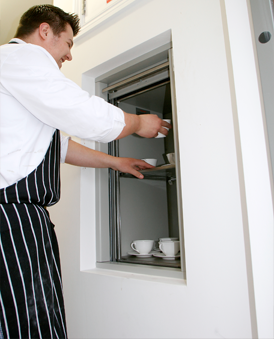Different types of service lifts and their uses
Contents |
Introduction
There are many different types of service lifts, all designed to offer simple, quick and efficient solutions where lifting problems may occur. Service lifts and dumbwaiter lifts are designed for a variety of professional environments, but they are not intended for human use.
This results in service lifts being exempt from many regulations which apply to other lift types. They are also highly flexible, as they tend to occupy less space than other lifts.
Service lifts can offer improvements in productivity, adapting to businesses needs whilst following building regulations.
Dumb waiter lifts
Dumb waiter lifts, also known as micro-lifts, food lifts or kitchen lifts, are used for transporting food or drink between floors. They are most commonly found within restaurants, bars, pubs, or within the homes of individuals with limited mobility. They are sometimes also installed in retail, office and medical environments.
They were first invented in the 19th century, with the original meaning of the phrase indicating a device more akin to a serving tray. Dumb waiter lifts can be adjusted to suit premises which are restricted in terms of headroom and have problematic maintenance access and limited space.
Dumbwaiter lifts can carry an average of 50-100 kg, and can move at 0.35 m/sec to serve up to six separate floors.
Dumb waiter lifts can improve business efficiency by transporting meals, materials, or other objects in less time than would be possible by foot. Additionally, they can reduce the strain on a person’s body or the risk of injury from carrying objects.
Trolley lifts
Trolley lifts are useful in circumstances where larger and heavier loads need to be transported, and can handle loads up to 300 kg. Used in settings such as retail, hotel or commercial premises to transport trolleys and crates, they can serve the same number of floors as dumb waiters, generally up to six floors, but they are slightly slower, with an average speed of 0.17 m/sec.
Operating inside a structure-supported frame, a trolley lift is easy to install and causes little disruption to business, and, with no motor room or ‘load-bearing’ shaft required, they are also cheaper.
Continuing technological innovations result in a typically lower cost, and their quick installation causes minimal disruption.
Find out more
Related articles on Designing Buildings Wiki
- Considerations When Installing a Residential Lift.
- Escalator.
- Lifting device.
- Lifts and Their Special Operating Modes.
- Lifts for buildings.
- Lifts for office buildings.
- The importance of service lifts.
- The science of lifts.
--Nathan Massey 14:22, 16 Oct 2017 (BST)
Featured articles and news
One of the most impressive Victorian architects. Book review.
RTPI leader to become new CIOB Chief Executive Officer
Dr Victoria Hills MRTPI, FICE to take over after Caroline Gumble’s departure.
Social and affordable housing, a long term plan for delivery
The “Delivering a Decade of Renewal for Social and Affordable Housing” strategy sets out future path.
A change to adoptive architecture
Effects of global weather warming on architectural detailing, material choice and human interaction.
The proposed publicly owned and backed subsidiary of Homes England, to facilitate new homes.
How big is the problem and what can we do to mitigate the effects?
Overheating guidance and tools for building designers
A number of cool guides to help with the heat.
The UK's Modern Industrial Strategy: A 10 year plan
Previous consultation criticism, current key elements and general support with some persisting reservations.
Building Safety Regulator reforms
New roles, new staff and a new fast track service pave the way for a single construction regulator.
Architectural Technologist CPDs and Communications
CIAT CPD… and how you can do it!
Cooling centres and cool spaces
Managing extreme heat in cities by directing the public to places for heat stress relief and water sources.
Winter gardens: A brief history and warm variations
Extending the season with glass in different forms and terms.
Restoring Great Yarmouth's Winter Gardens
Transforming one of the least sustainable constructions imaginable.
Construction Skills Mission Board launch sector drive
Newly formed government and industry collaboration set strategy for recruiting an additional 100,000 construction workers a year.
New Architects Code comes into effect in September 2025
ARB Architects Code of Conduct and Practice available with ongoing consultation regarding guidance.
Welsh Skills Body (Medr) launches ambitious plan
The new skills body brings together funding and regulation of tertiary education and research for the devolved nation.
Paul Gandy FCIOB announced as next CIOB President
Former Tilbury Douglas CEO takes helm.
























